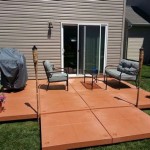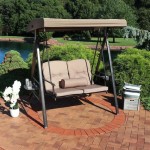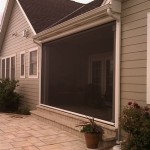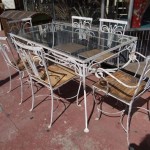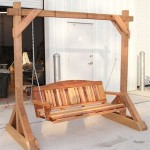How To Make The Most Of Your Patio Swing Canopy Replacement
A patio swing provides a relaxing outdoor seating option, offering a gentle rocking motion that promotes tranquility. A crucial component of this outdoor furniture is the canopy, which shields occupants from the sun and light rain. Over time, exposure to the elements can degrade the canopy, necessitating a replacement. A thoughtful approach to the replacement process can significantly enhance the longevity and functionality of the patio swing.
Understanding the factors that contribute to canopy degradation is crucial. Prolonged exposure to ultraviolet (UV) radiation from the sun is a primary cause. UV rays break down the fibers of the fabric, leading to fading, cracking, and eventual tearing. Similarly, consistent exposure to moisture, whether from rain, dew, or humidity, can foster the growth of mold and mildew, which further weakens the material. High winds can also place undue stress on the canopy, particularly if it is not properly secured or if the material is already weakened. Physical abrasion from tree branches or other objects can also contribute to wear and tear.
Before initiating the replacement process, it is important to accurately assess the existing swing and canopy infrastructure. Determine the specific model of the swing, if possible. Reviewing the manufacturer's documentation or searching online using the swing's identifying marks can provide valuable information regarding the original canopy specifications. If the model cannot be readily determined, precise measurements of the existing canopy frame are essential. This includes the length, width, and height dimensions as well as the curvature or slope of the canopy. Note the type of attachment mechanism used to secure the canopy to the frame; this can include grommets, hook-and-loop fasteners (such as Velcro), or fabric loops that slide over the frame. Taking photographs and drawing diagrams can aid in accurately documenting these details, ensuring a compatible replacement is selected.
Selecting a Suitable Replacement Canopy
Choosing the right replacement canopy is paramount to ensuring a proper fit, adequate protection, and extended durability. Several factors should be considered during the selection process, including the material, size, attachment mechanism, and desired features.
The material composition of the canopy significantly impacts its resistance to the elements. Polyester is a common choice, offering a balance of affordability, durability, and water resistance. Solution-dyed polyester, in which the color is integrated into the fiber during manufacturing, provides superior fade resistance compared to fabrics that are surface-dyed. Acrylic fabrics, such as those used in outdoor awnings, are known for their excellent UV resistance and colorfastness, but they generally come at a higher price point. Canvas, typically made from cotton or a cotton blend, offers a natural aesthetic but requires more frequent cleaning and waterproofing to prevent mildew growth. Consider the climate in which the swing will be used when selecting the material. In areas with high rainfall, a waterproof or water-repellent fabric is essential. In sunny regions, UV resistance is the priority.
Accurate measurements are critical for ensuring a proper fit. A canopy that is too small will be difficult or impossible to install, while one that is too large will sag and may be more susceptible to wind damage. Use the measurements taken from the existing canopy frame as a guide. Consider the attachment mechanism used by the original canopy. If the original canopy used grommets, the replacement should have grommets in the same locations and of a compatible size. Hook-and-loop fasteners should align correctly to ensure a secure attachment. Fabric loops should be appropriately sized to slide over the frame without excessive stretching or bunching. Confirm that the replacement canopy is compatible with the existing frame structure to avoid modifications or the purchase of additional hardware.
Beyond basic functionality, there are several additional features to consider when selecting a replacement canopy. Some canopies include vents that allow air to circulate, reducing the risk of the canopy being lifted by strong winds and minimizing heat buildup underneath. Others offer additional UV protection, exceeding the standard UPF (Ultraviolet Protection Factor) rating of common outdoor fabrics. Consider a canopy with a water-repellent coating to enhance its resistance to rain. Reinforced corners and seams can provide added durability in areas that are prone to stress. Some replacement canopies may also offer aesthetic options, such as a wider range of colors and patterns, allowing for customization of the patio swing's appearance.
Preparing The Patio Swing And Installing The Replacement Canopy
Proper preparation of the patio swing frame is an essential step before installing the new canopy. This ensures a smooth and secure installation process, maximizing the lifespan of both the canopy and the swing itself.
Begin by thoroughly cleaning the swing frame. Remove any dirt, dust, debris, or remnants of the old canopy. A mild soap solution and a soft brush are generally sufficient for this task. Pay particular attention to areas where the canopy attaches to the frame, such as grommets, hook-and-loop fasteners, or fabric loops. Ensure that these areas are free from corrosion or any buildup that might impede the attachment process. Rinse the frame thoroughly with clean water and allow it to dry completely before proceeding.
Inspect the swing frame for any signs of damage, such as rust, cracks, or loose joints. Address any issues before installing the new canopy. Light surface rust can be removed with a wire brush and treated with a rust-inhibiting primer. Cracks or loose joints should be repaired or reinforced as needed. If the frame is significantly damaged, consider repairing or replacing the affected components before proceeding. A stable and structurally sound frame is essential for ensuring the proper support and longevity of the canopy.
Install the replacement canopy according to the manufacturer's instructions. Generally, this involves aligning the canopy with the frame and securing it using the appropriate attachment mechanism. If the canopy uses grommets, ensure that the grommets are properly aligned with the frame and that the attachment hardware (e.g., screws or bolts) is securely fastened. Hook-and-loop fasteners should be aligned carefully to ensure a strong and even bond. Fabric loops should be slid over the frame smoothly and evenly, avoiding any excessive stretching or bunching. Begin at one corner or side and work your way around the entire frame, ensuring that the canopy is taut and evenly distributed. Avoid overtightening or stretching the canopy, as this can weaken the material and lead to premature failure.
Maintaining The New Canopy To Maximize Its Lifespan
Regular maintenance is crucial for extending the lifespan of the replacement canopy and preserving its appearance. Following these simple practices can significantly reduce the risk of damage and prolong the canopy’s functionality.
Clean the canopy regularly to remove dirt, dust, and debris. A soft brush or vacuum cleaner can be used to remove loose particles. For more stubborn dirt or stains, use a mild soap solution and a soft cloth. Avoid using harsh chemicals or abrasive cleaners, as these can damage the fabric. Rinse the canopy thoroughly with clean water and allow it to air dry completely before using the swing. Address stains promptly to prevent them from setting into the fabric. Follow the manufacturer's instructions for specific cleaning recommendations.
When the patio swing is not in use, particularly during periods of inclement weather, consider covering the canopy to protect it from the elements. A waterproof cover will shield the canopy from rain, snow, and UV radiation, extending its lifespan. Alternatively, consider removing the canopy and storing it indoors during extended periods of non-use. This is particularly beneficial during the winter months or during periods of heavy storms. Proper storage will prevent the canopy from being damaged by the elements and will help to maintain its appearance.
Periodically inspect the canopy for signs of wear and tear, such as fading, cracking, or tearing. Address any issues promptly to prevent them from worsening. Small tears can often be repaired with a fabric patch or by sewing. Faded areas can be treated with a fabric protectant to help restore their color and UV resistance. Replace the canopy if the damage is too extensive to repair or if the material has become significantly weakened. Regular inspections and timely repairs will help to extend the lifespan of the canopy and maintain its functionality.
How To Make A Swing Canopy Sailrite

How To Replace An Outdoor Swing Canopy

How To Make A Swing Canopy With Valance Edge
How To Replace The Canopy On A Patio Swing Sailrite

How To Make A Swing Chair Canopy The Carpenter S Daughter

Patio Swing Makeoverdiy Show Off Diy Decorating And Home Improvement Blog
How To Replace Fabric On A Patio Swing Sailrite

Outsunny Heavy Duty Metal 3 Seater Outdoor Swing Chair Garden Hammock Bed With Canopy And 2 Pillows Beige Aosom

Convertible Canopy Swing Glider 3 Seater Best Choice S

Patio Swing Makeoverdiy Show Off Diy Decorating And Home Improvement Blog
Related Posts

